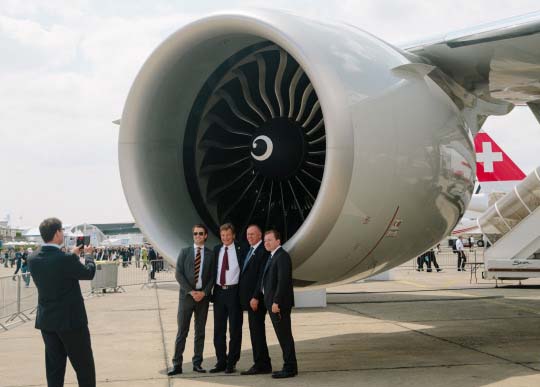
February 18, 2020

SILVER ANNIVERSARY
Punxsutawney Phil cast no shadow on Groundhog Day 1995: North America was in for an early spring. Hundreds of miles east that same morning, a fresh season in commercial aviation was also dawning. The Federal Aviation Administration gave the go-ahead on a giant new aircraft engine called the GE90. While FAA reps gathered at GE Aviation headquarters in Ohio, a Boeing 777 equipped with the engines sat on a runway in Washington, awaiting the OK. Even before it took to the skies, everybody involved in the project understood what a big deal they were witnessing. Brian Rowe, who led GE Aviation at the time, said, “The GE90 will be the engine that will lead the way to the 21st century.”
Generations of success: The GE90 engine, and twin-engine planes like the Boeing 777, went on to reinvent jet travel, opening an era of cost-efficient long-haul flights. (Previously, four engines were typically the standard for long-distance trips.) It also introduced much of the cutting-edge tech found in today’s finest airplane engines, including carbon-fiber composites, and, over time, 3D-printed parts. Those technologies, in fact, helped GE Aviation beat its own record. The GE90 reigned as the world’s most powerful aircraft engine until last year, when it was bested by another GE design: the GE9X for the 777’s successor, the 777X jet. “It all started with this engine,” said Jim Elliott, a principal engineer at GE Aviation. “It has exceeded all expectations and become the envy of the industry.”
Learn more here.
LEADING THE CHARGE
In “Back to the Future,” when Doc Brown attempts to harness lightning to jump-start the DeLorean, he provides an inadvertent lesson in the workings of power electronics — the systems that send electricity around in cars and other machines and devices. As cars become increasingly electric, the importance of power electronics is surging. Engineers at the U.S. Army Research Laboratory (ARL), for instance, are working on building resilient, lightweight and compact power electronics for the Army’s growing fleet of electric vehicles. And they’re getting some help: Last week, GE Research announced plans to collaborate with ARL to take the semiconductors in those EVs to the next level.
It’s positively electrifying: EVs might look outwardly similar to internal-combustion vehicles, but under the hood it’s another story entirely. Instead of pistons and valves, EVs need a charger, batteries, an electric traction motor — and on and on. The key to ensuring that these systems work in tandem is semiconductors, similar to the silicon semiconductors found in phones and computers. Silicon will have a hard time in Army EVs, though, which require power electronics made from materials that can handle higher voltages and temperatures. Enter the silicon carbide (SiC): A single one of these power electronics can do the job of numerous silicon devices working in parallel, which reduces the size and weight of the electrical apparatus in the Army’s EVs, boosting the speed and mobility of the force’s truck.
Not so fast, though: SiC chips are pretty hard to make. That’s where GE’s engineers come in. Learn more here.
WILD BLUE YONDER
World War II was the first war to be extensively documented on film — including 15 hours of raw color footage shot from a B-17 Flying Fortress. Those precious images didn’t come to light until recently, when documentarian Erik Nelson found it in the National Archives. He turned the footage into the documentary “The Cold Blue,” released last year to coincide with the 75th anniversary of D-Day. The film shows the heroism and struggle of airmen risking life high above Europe, the planes that carried them aloft, and the technology that powered the air war.
Above the clouds: The footage was originally shot by Hollywood director William Wyler for “The Memphis Belle,” a 1944 documentary following one B-17 crew as they completed 25 missions before returning home. Preparing “The Cold Blue,” Nelson interviewed nine surviving airmen, who recalled the harsh conditions they endured, including freezing-cold temperatures aboard the planes. They had warmer recollections of those B-17s, though, whose GE-made superchargers allowed them to fly efficiently at high altitudes. “The B-17 engines were an unbelievably reliable and steady and battle-tested piece of machinery,” Nelson said. “They kept running and they brought many a pilot back, sometimes with only two engines, and in some cases only one engine.”
“The Cold Blue” is currently available on HBO Now. Learn more here about the making of it.
COOLEST THINGS ON EARTH ?
1. Monkey, Awake
Neuroscientists at the University of Wisconsin-Madison found that mild, precisely targeted electric stimulation could rouse monkeys from an unconscious state — suggesting a possible treatment for brain disorders including coma.
2. The Sixth Sense
At MIT, “sensorized skin” could help robots gain yet another ability that humans take for granted: the way we sense our physical position in three-dimensional space.
3. Organ Of Progress
A team of researchers in Munich found a way to enable the 3D imaging of an entire human organ at the cellular level, which could lead the way to the 3D printing of artificial organs — and help solve a persistent organ shortage.
Read more here about this week’s Coolest Things on Earth.
— QUOTE OF THE DAY —
“It all started with this engine. It has exceeded all expectations and become the envy of the industry.”
— Jim Elliott, a principal engineer at GE Aviation
Quote: GE Reports. Image credit: Adam Senatori for GE Reports.
ENJOY THIS NEWSLETTER?
Please send it to your friends and let them know they can subscribe here.




